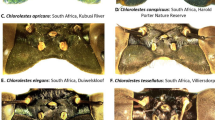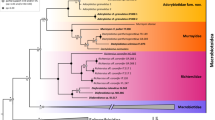Abstract
With the aim to analyze the phylogenetic relationships of Dromaeosauridae with respect to other paravians we performed a phylogenetic analysis using the most recent version of the data matrix published by the TwiG, presented by Hu et al. (2009) and modified by Agnolín and Novas (2010).
Access provided by Autonomous University of Puebla. Download chapter PDF
Similar content being viewed by others
Keywords
These keywords were added by machine and not by the authors. This process is experimental and the keywords may be updated as the learning algorithm improves.
In order to study sequences of appearance of synapomorphies in the theropod line to birds, we have polarized ingroup characters in the data matrix based on outgroup comparisons (i.e., Allosaurus and Sinraptor). Most characters are coded as binary (0, plesiomorphic; 1, apomorphic), with the exception of some multistate characters, for which 0 is plesiomorphic and 1,2, and/or 3 represents apomorphic states, considered as a progressive sequence. Question mark (?) indicates that the character state is unknown in available specimens. The script (-) indicates that due to the high apomorphic modifications of the taxon, the character state cannot be checked. These codifications are tabulated in a data matrix to show the distributions of character states.
With the aim to analyze the phylogenetic relationships of Dromaeosauridae with respect to other paravians we performed a phylogenetic analysis using the most recent version of the data matrix published by the TwiG, presented by Hu et al. (2009) and modified by Agnolín and Novas (2011). Definitions of characters 1 through 363 follow Hu et al. (2009); characters 364 through 366 have been modified from Novas et al. (2009). We added characters 369–412 from Xu et al. (2008) dataset. Character 367 is from Gianechini et al. (2009), character 368 has been added from Zheng et al. (2009), characters 413–415 have been added from Xu (2002), characters 416–426 were added from Xu et al. (2011a), and characters 427–429 are added from Osmólska et al. (2004). We have modified character 240 from Hu et al. (2009), in reducing the number of character states from 4 to 2. In this way, the present analysis contains one of the most comprehensive dataset employed up to now, consisting of 88 taxa scored for 429 characters (see Appendix 1–2). Codifications by previous authors were analyzed in detail, and consequently, several characters from the combined data matrix of Xu et al. (2008), Hu et al. (2009) and Agnolín and Novas (2011), and Xu et al. (2011a) were re-scored (Appendix 2).
Phylogenetic analysis was performed using TNT 1.1 (Goloboff et al. 2008). All characters were equally weighted and treated as unordered. A heuristic search was performed with 10,000 replicates of the tree bisection and reconnection (TBR) branch-swapping algorithm. The maximum number of trees saved for each random addition sequence replicate was set to 100.
The phylogenetic analysis resulted in the recovery of 50 Most Parsimonious Trees (MPTs), which bring a Strict Consensus Tree of 1841 steps, with a consistency index of 0.27, and a retention index of 0.69 (Fig. 2.1).
As proposed by Makovicky et al. (2005), we consider Neuquenraptor argentinus Novas and Pol (2005) as junior synonym of Unenlagia comahuensis Novas and Puerta 1997 (contra Porfiri et al. 2011), and we follow Agnolín and Novas (2011) in the use of the original family name Unenlagiidae Bonaparte (1999) (instead of Unenlagiinae; sensu Makovicky et al. 2005), to emphasize the distinctiveness of this theropod group.
Abbreviations
- HMN:
-
Museum für Naturkunde, Berlin, Germany;
- IVPP V:
-
The Institute of Vertebrate Paleontology and Paleoanthropology, Beijin, China;
- MCF PVPH:
-
Museo Carmen Funes, Plaza Huincul, Neuquén, Argentina;
- MML:
-
Museo Municipal de Lamarque, Lamarque, Río Negro, Argentina;
- MPCA:
-
Museo Provincial Carlos Ameghino, Cippolletti, Río Negro, Argentina;
- UA:
-
University of Antananarivo, Madagascar;
- YPM:
-
Yale Peabody Museum, Yale, USA.
References
Agnolín FL, Novas FE (2011) Unenlagiid theropods: are they members of Dromaeosauridae (Theropoda, Maniraptora). An Acad Bras Ciênc 83:117–162
Bonaparte JF (1999) Tetrapod faunas from South America and India: a palaeobiogeographic interpretation. Proc India Acad Sci 65:427–437
Gianechini FA, Apesteguía S, Makovicky PJ (2009) The unusual dentition of Buitreraptor gonzalezorum (Theropoda, Dromaeosauridae), from Patagonia, Argentina: new insights on the unenlagine teeth. Ameghiniana 52:36A
Goloboff PA, Farris JS, Nixon KC (2008) TNT, a free program for phylogenetic analysis. Cladistics 24:774–786
Hu D, Hou L, Zhang L, Xu X (2009) A pre-Archaeopteryx troodontid theropod from China with long feathers on the metatarsus. Nature 461:640–643
Makovicky PJ, Apesteguía S, Agnolín FL (2005) The earliest dromaeosaurid theropod from South America. Nature 437:1007–1011
Novas FE, Pol D (2005) New evidence on deinonychosaurian dinosaurs from the Late Cretaceous of Patagonia. Nature 433:858–861
Novas FE, Puerta P (1997) New evidence concerning avian origins from the Late Cretaceous of NW Patagonia. Nature 387:390–392
Novas FE, Pol D, Canale JI, Porfiri JD, Calvo JO (2009) A bizarre cretaceous theropod dinosaur from Patagonia and the evolution of Gondwanan dromaeosaurids. Proc Royal Soc London B 126:1101–1107
Osmólska H, Currie PJ, Barsbold R (2004) Oviraptorosauria. In: Weishampel DB, Dodson P, Osmolska H (eds) The Dinosauria, 2nd edn. University of California Press, Berkeley, pp 165–183
Porfiri JD, Calvo JO, Santos D (2011) A new small deinonychosaur (Dinosauria: Theropoda) from the Late Cretaceous of Patagonia, Argentina. An Acad Bras Ciênc 83:109–116
Xu X (2002) Deinonychosaurian fossils from the Jehol Group of western Liaoning and the coelurosaurian evolution. Dissertation for the doctoral degree. Chinese Academy of Sciences, Beijing
Xu X, Zhao Q, Norell MA, Sullivan C, Hone D, Erickson PG, Wang X, Han F, Guo Y (2008) A new feathered dinosaur fossil that fills a morphological gap in avian origin. Chinese Sci Bull 54:430–435
Xu X, You H, Du K, Han F (2011a) An Archaeopteryx-like theropod from China and the origin of Avialae. Nature 475:465–470
Zheng X, Xu X, You H, Zhao Q, Dong Z (2009) A short-armed dromaeosaurid from the Jehol Group of China with implications for early dromaeosaurid evolution. Proc Royal Soc London B 277:211–217
Author information
Authors and Affiliations
Corresponding author
Rights and permissions
Copyright information
© 2013 Springer Science+Business Media Dordrecht
About this chapter
Cite this chapter
Agnolín, F.L., Novas, F.E. (2013). Materials and Methods. In: Avian Ancestors. SpringerBriefs in Earth System Sciences. Springer, Dordrecht. https://doi.org/10.1007/978-94-007-5637-3_2
Download citation
DOI: https://doi.org/10.1007/978-94-007-5637-3_2
Published:
Publisher Name: Springer, Dordrecht
Print ISBN: 978-94-007-5636-6
Online ISBN: 978-94-007-5637-3
eBook Packages: Earth and Environmental ScienceEarth and Environmental Science (R0)





